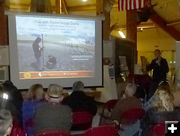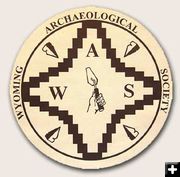

Radiocarbon dates
Archaeologist Bob Kelly spoke to the local chapter of the Wyoming Archaeological Society in Pinedale on Nov. 27th.
|
|
Itís not what you find, itís what you find out
Fun With Radiocarbon Dates
by Dawn Ballou, Pinedale Online!
November 28, 2018
On Tuesday, Nov. 27th, the Upper Green River Basin Chapter of the Wyoming Archaeological Society held their regular meeting at the Museum of the Mountain Man in Pinedale. They hosted special guest Bob Kelly who gave a talk on "Fun with Radiocarbon Dates." Kelly has been doing archaeology for the past 45 years in the western United States, including 20 years in Wyoming.
Kelly started his talk by borrowing a great quote from someone else, in archaeology "Itís not what you find, itís what you find out" that is really important.
Radiocarbon dating is the primary way archaeologists date archaeological sites. Radiocarbon dating is a method that provides objective age estimates for carbon-based materials that originated from living organisms. The test works on organic material like charcoal, leather, hair, shells, bones, and teeth. It doesnít work on fossilized items. The effective range for radiocarbon dating is to about 45,000 years ago. 82% of the radio carbon dates in Wyoming are from charcoal.
In North America, the archaeological record goes back to about 15,000 years ago, although some researchers think there may be evidence of habitation earlier than that. Many different researchers have collected radiocarbon dates from their archaeological sites over the years. With funding from the National Science Foundation, Kelly has been working with people around the country to compile these independent radiocarbon dating information into a database for the lower 48 states.
Canada has been compiling radiocarbon dates in that country for a number of years now. As part of their project compiling Canadian dates, they also compiled dates from Alaska. No one has done a compilation of radiocarbon date data for Mexico or South America yet.
The compiled Canadian and U.S. data will be housed in British Columbia with the Canadian project. All the information will ultimately be available online.
Cost to do radiocarbon dating ranges from about $350 to $600/sample making it still relatively expensive to do.
Kelly said they are seeing some correlation of radiocarbon data with estimated populations and relationships to temperature, moisture and other climate data over time. There appears to be a synchronization of human population growth across the planet for the past 10,000 years, despite those populations not being connected to each other.
Wyoming and Colorado appear to have had their greatest prehistoric population peak around 1200 years ago, which also seems to hold true across the North American continent. Then, for some reason, population everywhere crashed. Europeans arrived to North America around 500 years ago. Scientists can only speculate on the cause of the population decline. There is evidence that the Vikings made it as far as Greenland 1,000 years ago. Is it possible they traveled further to the North American mainland and could they possibly have unwittingly brought devastating contagious European diseases with them to the native populations? Were there catastrophic climatic changes around that time? Was there widespread warfare between indigenous people that decimated populations across the continent? At this time, the answers arenít known, but researchers are gaining intriguing new insights through the compilation and analysis of the increasing number of radiocarbon date data.
The Upper Green River Basin Chapter of the Wyoming Archaeological Society generally meets the 4th Tuesday of the month at the Museum of the Mountain Man in Pinedale. The Chapter is sponsored by the Museum. Dues are collected annually, in the spring. Membership dues are $20 for an individual and $25 for Family. Members receive copies of the publication "The Wyoming Archaeologist," which is published twice a year.
|

